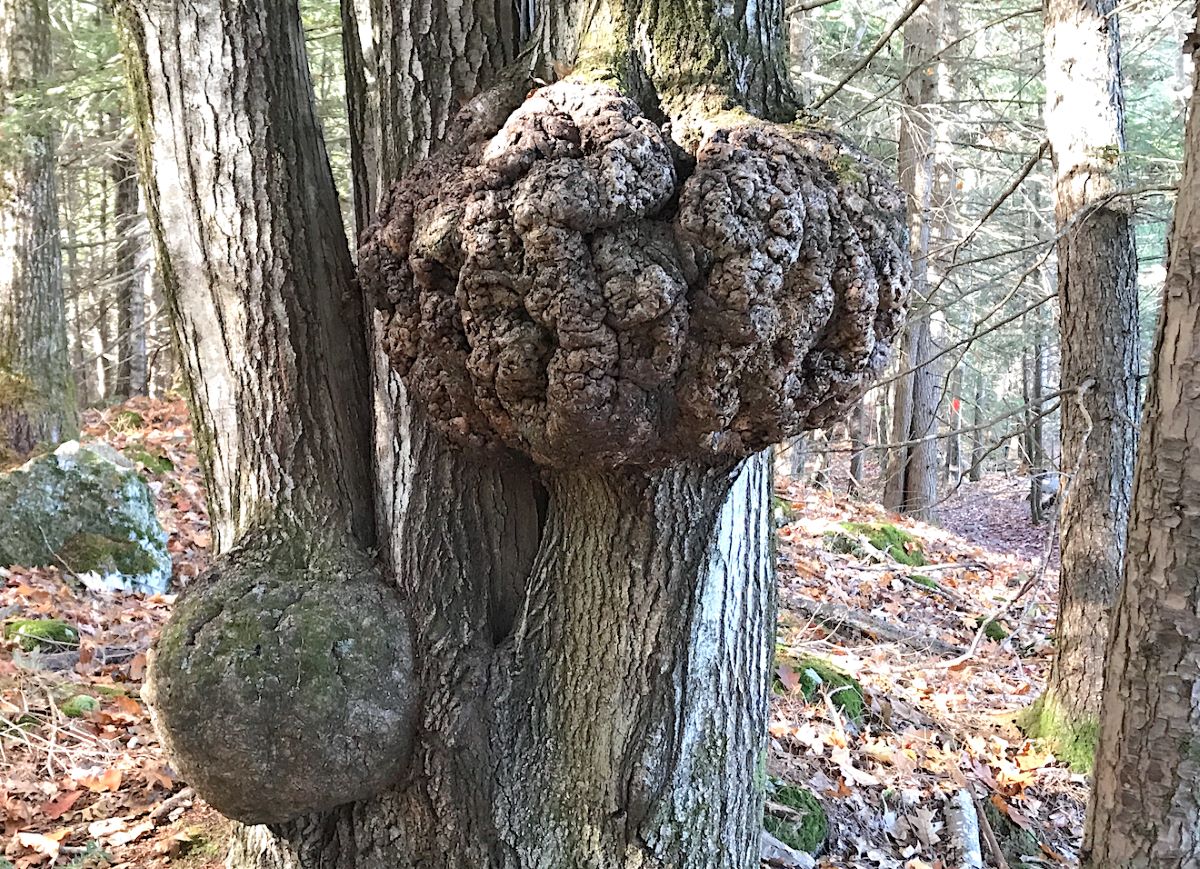Out in the Woods
- November 1st 2024
- Uncategorized

Burls on a multi-stemmed oak tree at Hall Environmental Reserve in Springvale
Photo: Kevin McKeon
Tree Burls a Bit of a Mystery
By Kevin McKeon, Maine Master Naturalist
Burls can be found on many tree species, but most often on oaks, maples, and cherries. Many woodworkers and woodturners are interested in the unusual grain patterns and colors found in burlwood. But what causes them to grow at all?
According to Kevin Smith, supervisory plant physiologist with the U.S. Forest Service, “A burl is the result of hyperplasia, a greatly abnormal proliferation of xylem production by the vascular cambium.” In other words, an area of a tree produces a wildly random growth pattern that’s initiated by hormonal changes.
What causes the hormonal changes? A theory for burl formation and growth is that it could be the tree’s protective reaction to an invasion of a bacteria, virus, or fungus, possibly initiated by insect attack. An insect causes a tiny injury in the tree while looking for food, sap, or an egg-laying spot, which opens a tiny wound that allows the virus or fungus entry. And sometimes burls form around an area of branch removal or damage. So, the tree may try to isolate the viral or fungal invasion by surrounding it with woody growth — the same process that oak trees use when they make those grape-like oak galls we see on our trail walks. Since the invasion doesn’t necessarily follow circular or straight lines of attack, the woody protective growth tends to be erratic as the tree’s growth follows the invasion. The burl grows, forming beautifully figured grain patterns that woodworkers love for their bowl turnings and clock faces.
If burl formation were better understood, commercial production would be possible to form a reliable source for marketing artisanal woodworking burls. A challenge to the market would be that the final appearance of the grain figuring is highly unpredictable, known only after a burl is cut into workable pieces. Another is that the twisting and turning grain patterns typically result in a weakness in structure, so the finished product would need to be a “form-over-function” product, unable to withstand common stresses that normal wood can.
Burls don’t seem to cause fatal damage to the tree, or even hurt it at all. But the random growth nature of the burl could cause an area of weakness, or even allow further invasive attacks by other pathogens. Foresters seem to be in general agreement that, for the overall health of the tree, it’s best to simply let the burl grow. Removing a large burl causes a wound that would offer entry to a host of pathogens and insects that could result in decay and tree death; Healing from such a wound would be extremely difficult.
So enjoy burls where you happen upon them, growing happily in their habitat and giving us trail walkers yet another opportunity to stop and ponder nature’s wonders and mysteries!
Oak galls: https://sanfordspringvalenews.com/nature/
Editor’s note: Did you see something unusual last time you were out in the woods? Were you puzzled or surprised by something you saw? Ask our “Out in the Woods” columnist Kevin McKeon. He’ll be happy to investigate and try to answer your questions. Email him directly at: kpm@metrocast.net






